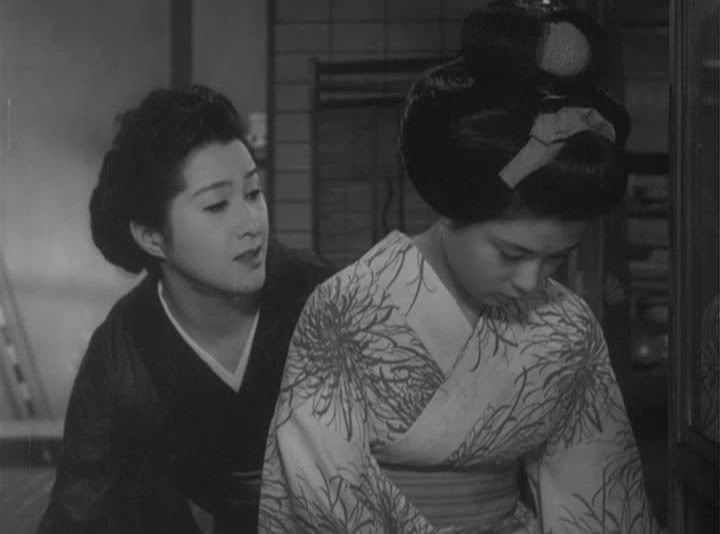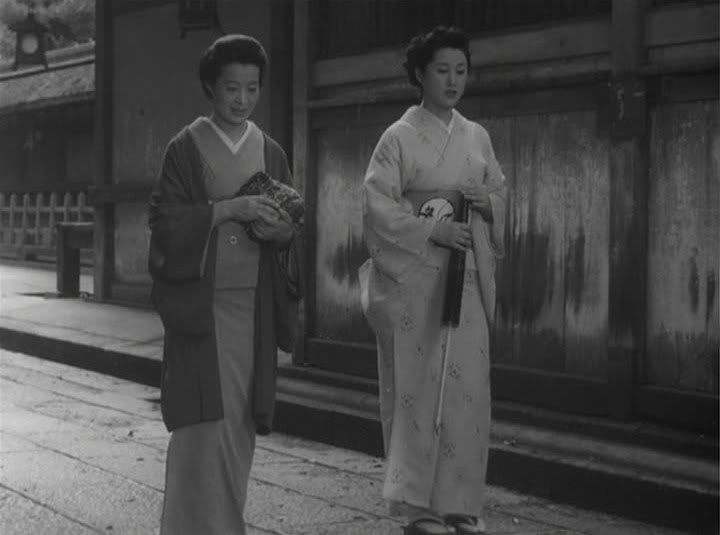
At the heart of Kenji Mizoguchi's Gion bayashi is the effect of changing sexual politics coming into contact with the traditional role of the geisha in Japanese culture. The film represents a dialectic between the traditional understanding of a woman's place as submissive and obedient and more modern attitudes regarding the ability of women to define their own desires and their own lives. Mizoguchi's film suggests that the reality of the world lags well behind these changing attitudes, as many expect the old ways to continue unchanged. This is a film, above all, about sexual exploitation, and it candidly examines the many ways in which women are exploited by the male-dominated society in which they must live. Eiko (Ayako Wakao) decides to become a geisha as a last resort: her mother was a geisha, and when she dies, Eiko is left with no one but an uncle who takes her in only on the condition that Eiko should sleep with him. Fleeing her uncle's sexual advances — forced upon her from a position of power and control — Eiko goes to the geisha Miyoharu (Michiyo Kogure) and begs to become a geisha. Miyoharu agrees to train the young girl, even though it would be at her own expense, because she sees that Eiko has nowhere else to go. The two women soon become embroiled in a complex set of pressures constricting them and limiting their choices, as they become pawns in the business plans of Kusuda (Seizaburo Kawazu) and Kanzaki (Kanji Koshiba).
The film's plot is relentless in documenting the pressures weighing down on Miyoharu and Eiko, as women whose sole role is to be desirable and solicitous, to tend to the needs of men as objects of beauty. Kusuda is a powerful older businessman who loves to be surrounded with young girls. He plays games with a harem of geisha like a little boy, running around and pantomiming baseball gestures, but he takes an especial liking to Eiko as soon as he meets her. Kusuda is also using Miyoharu as a tool in his attempts to get a lucrative contract, since the mid-level minister Kanzaki — who has the ability to make a decision on a business deal affecting Kusuda — falls in love with Miyoharu. Both women thus becomes objects in this business deal, ornaments to the negotiations between Kusuda and Kanzaki. The film carefully establishes the stakes, as Miyoharu and Eiko are manipulated into place by the powerful Madame Okimi (Chieko Naniwa), whose favor is necessary to find work as a geisha.
Miyoharu and Eiko are the only decent people in the film; everyone amassed around them is out to use them or exploit them in some way, especially but not only the cartoonishly lecherous Kusuda and Kanzaki. Eiko's father (Eitaro Shindo), an ailing and struggling storeowner, refuses to support his daughter, washing his hands of her and leaving her to either live with her sexually predatory uncle or to struggle wherever else she can. Later, however, when Eiko becomes a successful geisha renowned for her beauty, her father comes crawling around, begging Miyoharu for money, pathetically telling her that if she doesn't lend him some money he'll have no choice but to kill himself to escape his debt and his failing business. He tells her that he feels entitled to a share of his daughter's earnings — this despite his refusal to support her during the girl's training period to become a geisha, when Miyoharu was forced to borrow a great deal of money to establish Eiko as a geisha. Okimi, as well, is exploitative and predatory, with an old-school understanding of a geisha as basically a prostitute. Eiko resists the idea that she has to take on a "patron," and so does Miyoharu; the two women have more modern ideas, primarily the idea that they don't have to sleep with a man they don't like. This is anathema to Okimi, who tries to maneuver the two women into keeping Kusuda and Kanzaki happy.

The film's story is thus naturally melodramatic, with the character types deliberately exaggerated to maximize the horrors these women are subjected to. Mizoguchi's style, however, is low-key and unobtrusive, and the contrast between the direct, observational realism of his style — which captures in its delicate way the simple day-to-day lives of these people — and the passionate melodrama of the narrative creates a pleasing tension in the film's aesthetic. Mizoguchi's style doesn't call attention to itself, but in subtle ways he's constantly accentuating the film's themes, crafting striking compositions that guide the eye to the power relations that are at the heart of the film. One of the most suggestive images comes when Miyoharu, realizing that she has no choice if she wants to support herself and Eiko while keeping the younger girl pure, finally gives in and agrees to spend the night with Kanzaki. When she goes to see him, he's lounging on his belly on the floor, reading, and Mizoguchi shoots him from above, with Miyoharu towering above him as she walks in. The composition superficially suggests that the power relations are in favor of the woman, but the man's languorous pose and the gaze of entitlement he gives her as he says he's been expecting her work against the composition to suggest that in fact it's the man, languidly doing nothing and waiting for the woman to come serve him, who's in control here. The next shot, in which Miyoharu silently goes off into the corner to undo her complicated geisha robes and sashes, reinforces this impression. The geisha is a servant for the rich, and this scene subtly parallels Miyoharu's obsequious behavior with the many scenes of servants catering to the women throughout the rest of the film. If elsewhere the geisha is respected and served, treated with dignity, in the privacy of the bedroom she's expected to be a servant.
Mizoguchi's style is similarly effective in the scene where Eiko first hears that Miyoharu has spent the night with a man. Mizoguchi stages the scene in a single shot, from just outside the door of Eiko and Miyoharu's home. After Eiko hears the news, the door is closed, inserting a wooden grate over her, obscuring her reaction to the realization of what has been necessary to provide for her. The static shot, and the grating layered over it, simultaneously distance the viewer from Eiko's reaction and call attention to it. Mizoguchi's formalism is more restrained, more subtle than that of his contemporary Yasujiro Ozu, but there's still a clear sense of a constructed world in this film, not only in the artificial contrivances of the script but in the gentle aesthetic sensibility guiding the material. Ozu is an inevitable comparison here, since the theme Mizoguchi is addressing — the conflict between tradition and modernity in a changing postwar Japan — was Ozu's essential theme throughout his postwar work. In comparison, though Ozu is the bolder stylist, Mizoguchi is more overt and melodramatic than his peer, approaching this story as a big theme to be worked out, a message to be communicated, which is very unlike Ozu's method of allowing his themes to gradually emerge from the texture of ordinary lives. If in Ozu's films tradition and modernity are simply part of the fabric of everyday life, in Gion bayashi the script establishes these conflicts in broad strokes and constructs scenes and dialogues obviously intended to bring out one point or another.
This message-oriented perspective is sometimes grating and overbearing, but more often the delicacy of Mizoguchi's aesthetic and the warm, natural performances of his leads prevent the film from becoming too didactic. There's a tenderness and warmth between Miyoharu and Eiko that becomes more and more powerful the more the women suffer together, culminating in the late scene where Miyoharu tells the younger girl how much she loves and cares for her. Mizoguchi deliberately leaves the nature of this love ambiguous — Miyoharu doesn't say she loves the other girl like a daughter — because it's a multilayered bond that encompasses mother/daughter loyalty, friendship, and even a hint of attraction in the way he frames the two women so close together, their heads bowed toward one another in their shared grief. The film ends with them walking down the street together, side by side; in a world amassed against them on all sides, conspiring to sabotage the independent lives they desire, they can ultimately only count on one another.

2 comments:
I actually managed to see this film via the Masters of Cinema DVDs from the UK. It's hard to imagine a society where women had to go through things like this. Mizoguchi was very effective at portraying it as such a nightmare of social constriction. Not only here, but in many of his films. It's little wonder a law banning prostitution was passed after Streets of Shame, his final film, came out.
Yes, I have those MOC DVDs too, they're great. Mizoguchi definitely conveys how constricting and sad this life is for these women. It's a very affecting film with, as you say, an implicit social message about the treatment of women.
Post a Comment